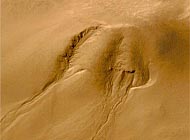Swiss scientists to assist survey of Martian interior

Instruments developed by Swiss scientists are to be used to probe activity under the surface of Mars, following Nasa's announcement that it has found evidence of liquid water on the Red Planet.
Professor Alex Halliday, of the Federal Institute for Technology in Zurich, said Switzerland had advised Nasa scientists surveying the Martian surface, and that Swiss know-how would play a crucial role in efforts to determine whether there really is water on the planet.
“The Swiss are going to be involved in putting instruments on Mars. These will make geophysical measurements of what’s going on inside the Martian interior.”
Astronomers have long believed that water exists on Mars, but it was thought to be locked up in ice at the poles and under the planet’s frozen surface. However, on Thursday astronomers said they had found convincing evidence that underground wells were actively pumping water to the surface.
Photographs from Nasa’s orbiting Mars global surveyor revealed topographical features, which appear to have been formed by large amounts of water bursting out and causing landslides.
“We see features that look like gullies formed by flowing water,” said Nasa scientist, Michael Malin. “The features appear so young that they might be forming today. We think we are seeing evidence of a ground water supply, similar to an aquifer.”
The discovery has renewed speculation that the planet may be home to primitive forms of life. The strongest evidence of life on Mars comes from a meteorite that fell to earth 13,000 years ago, and was found to contain chemical traces which could have been caused by bacteria.
Scientists believe that the presence of liquid water, even deep below the surface, would provide strong grounds for assuming that life exists there today.
The reason is that organisms have been found living in similar conditions on earth. Scientists now know that creatures exist in thermal vents at the bottom of the ocean, where no light can penetrate and the water pressure would crush any surface creature. Bacteria have also been found deep below the earth’s surface, in oil wells and even living in ice in the Arctic.
However, Alex Halliday cautions that Nasa’s “discovery” is still very far from being a reality. “Until we see more information, it’s very hard to see how reliable these claims really are. They are based on interpretation of data made remotely and interpretations of information obtained from past missions.”
Halliday also urges scepticism about claims that the discovery brings us closer to colonising Mars. “Colonising another planet is an extremely long way off. It’s not even worth considering at the moment. Even placing a person on Mars would be so enormously expensive as to be totally unfeasible.”
What is certain is that these findings are a huge boost to Nasa, which has suffered major setbacks recently. Last year, it lost two Mars missions in a row, and the organisation has admitted that it may have cut too many corners on recent missions.
swissinfo with agencies

In compliance with the JTI standards
More: SWI swissinfo.ch certified by the Journalism Trust Initiative
You can find an overview of ongoing debates with our journalists here . Please join us!
If you want to start a conversation about a topic raised in this article or want to report factual errors, email us at english@swissinfo.ch.